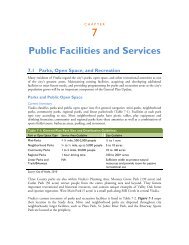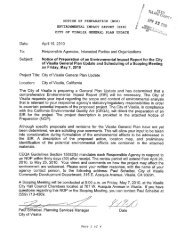General Plan Update Review Committee Draft Elements Part 2 For ...
General Plan Update Review Committee Draft Elements Part 2 For ...
General Plan Update Review Committee Draft Elements Part 2 For ...
You also want an ePaper? Increase the reach of your titles
YUMPU automatically turns print PDFs into web optimized ePapers that Google loves.
8-20 VISALIA GENERAL PLAN UPDATE<br />
Three aspects of community noise are used in assessing<br />
the noise environment:<br />
• Level (e.g., magnitude or loudness). Sound levels<br />
are measured and expressed in decibels (dB) with<br />
10 dB roughly equal to the threshold of hearing.<br />
Figure 8-5 shows the decibel levels associated with<br />
different common sounds. Transient noise events<br />
may be described by their maximum A weighted<br />
noise level (dBA).<br />
• Frequency composition or spectrum. Frequency<br />
is a measure of the pressure fluctuations per<br />
second, measured in units of hertz (Hz). The<br />
characterization of sound level magnitude with<br />
respect to frequency is the sound spectrum, often<br />
described in octave bands, which divide the<br />
audible human frequency range (e.g., from 20 to<br />
20,000 Hz) into 10 segments.<br />
• Variation in sound level with time, measured<br />
as noise exposure. Most community noise is<br />
produced by many distant noise sources that<br />
change gradually throughout the day and produce<br />
a relatively steady background noise having no<br />
identifiable source. Identifiable events of brief<br />
duration, such as aircraft flyovers, cause the<br />
community noise level to vary from instant to<br />
instant. A single number called the equivalent<br />
sound level or Leq describes the average noise<br />
exposure level over a period of time. Hourly L eq<br />
values are called Hourly Noise Levels.<br />
Reporting Noise Levels<br />
Measuring and reporting noise levels involves<br />
accounting for variations in sensitivity to noise during<br />
the daytime versus nighttime hours. Noise descriptors<br />
used for analysis need to factor in human sensitivity<br />
to nighttime noise when background noise levels are<br />
generally lower than in the daytime and outside noise<br />
intrusions are more noticeable. Common descriptors<br />
include the Community Noise Equivalent Level<br />
(CNEL) and the Day-Night Average Level (DNL).<br />
Both reflect noise exposure over an average day with<br />
weighting to reflect the increased sensitivity to noise<br />
during the evening and night. The two descriptors<br />
are roughly equivalent. The CNEL descriptor is used<br />
in relation to major continuous noise sources, such<br />
as aircraft or traffic, and is the reference level for the<br />
Noise Element under State planning law.<br />
Knowledge of the following relationships is helpful in<br />
understanding how changes in noise and noise exposure<br />
are perceived:<br />
• Except under special conditions, a change in<br />
sound level of 1 dB cannot be perceived;<br />
• A 3 dB change is considered a just noticeable<br />
difference;<br />
• A 5 dB change is required before any noticeable<br />
change in community response would be expected.<br />
A 5 dB increase is often considered a significant<br />
impact; and<br />
• A 10 dB increase is subjectively heard as an<br />
approximate doubling in loudness and almost<br />
always causes an adverse community response.<br />
According to common practice, maximum noise levels<br />
of 60 dB are considered “normally acceptable” for<br />
unshielded residential development. Noise levels from<br />
60 dB to 70 dB fall within the “conditionally unacceptable”<br />
range, and those in the 70 to 75 dB range<br />
are considered “normally unacceptable.”




